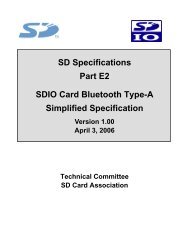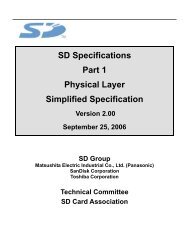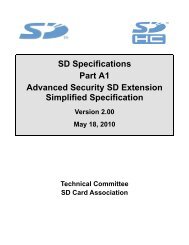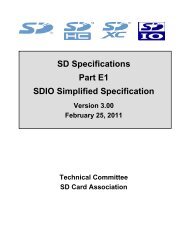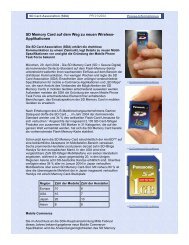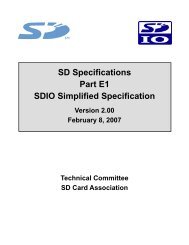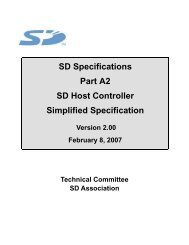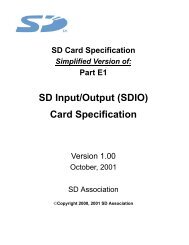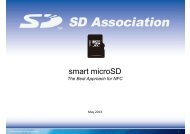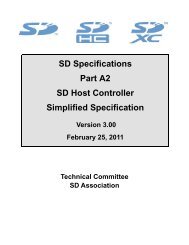SD Specifications Part 1 UHS-II Simplified Addendum - SD Association
SD Specifications Part 1 UHS-II Simplified Addendum - SD Association
SD Specifications Part 1 UHS-II Simplified Addendum - SD Association
You also want an ePaper? Increase the reach of your titles
YUMPU automatically turns print PDFs into web optimized ePapers that Google loves.
<strong>UHS</strong>-<strong>II</strong> <strong>Simplified</strong> <strong>Addendum</strong> Version 1.01©Copyright 2010-2013 <strong>SD</strong> Card <strong>Association</strong>CPU S/WLegacy<strong>SD</strong> I/FHostTx<strong>UHS</strong>-<strong>II</strong> I/FControllerTx/Rx Rx/TxD0 Lane (default Downstream)includingD0.Tx, D0.Rx Port and D0 Line(D0.Tx / D0.Rx Port also have Rx / Tx respectively)Host PHYincludingRCLK.Tx, D0.Tx and D1.Rx PortRCLK LineD0 LineRCLK LaneincludingRCLK.Tx, RCLK.RxPort and RCLK LineD1 LineLinkincludingRCLK, D0 and D1 LaneLegacy<strong>SD</strong> I/FRxDeviceRx/TxController<strong>UHS</strong>-<strong>II</strong> I/FTx/RxDevice PHYincludingRCLK.Rx, D0.Rx and D1.Tx PortD1 Lane (default Upstream)includingD1.Tx, D1.Rx Port and D1 Line(D1.Tx / D1.Rx Port also have Rx / Tx respectively)Figure 3-3 : Point to Point Topology (Supporting 2L-HD Mode)The default direction of D0 Lane is downstream, and D1 is upstream. If Host decides to send data toDevice in 2L-HD mode, D1 Lane changes downstream temporarily (Figure 3-4 (a)). Similarly if Hostdecides to get data from Device in 2L-HD mode, D0 changes upstream (Figure 3-4 (b)). As a result, allPorts for data Lanes are necessary to have both functions of Tx and Rx.(a)(b)CPU S/WCPU S/WLegacy<strong>SD</strong> I/FHostTx<strong>UHS</strong>-<strong>II</strong> I/FControllerTx/Rx Rx/TxD0 Lane(Downstream)Host PHY(D1.Rx Port is temporarily switched to Tx)Legacy<strong>SD</strong> I/FHostTx<strong>UHS</strong>-<strong>II</strong> I/FControllerTx/Rx Rx/TxD0 Lane(temporary Upstream)Host PHY(D0.Tx Port is temporarily switched to Rx)Legacy<strong>SD</strong> I/FRxDeviceRx/TxController<strong>UHS</strong>-<strong>II</strong> I/FTx/RxDevice PHY(D1.Tx Port is temporarily switched to Rx)D1 Lane(temporarily Downstream)Legacy<strong>SD</strong> I/FDeviceController<strong>UHS</strong>-<strong>II</strong> I/FFigure 3-4 : Direction Changing in 2L-HD ModeRxRx/TxTx/RxDevice PHY(D0.Rx Port is temporarily switched to Tx)D1 Lane(Upstream)3.1.2 Multi-device ConnectionIn order that Host can control or communicate with multiple Devices, <strong>UHS</strong>-<strong>II</strong> provides Multi-deviceconnection. There are two types of topologies to realize Multi-device connection, one is Ring connectionand the other is Hub connection. Ring connection is introduced to realize a cost effective topology thatminimizes the total number of PHY in the embedded system. And Hub connection is introduced torealize more flexible topology compared to Ring, in terms of capability of hot insertion and removal.Note that RCLK shall be distributed individually to removable Devices, and not only <strong>UHS</strong>-<strong>II</strong> interface butalso Legacy <strong>SD</strong> interface shall be connected to removable Devices.5



